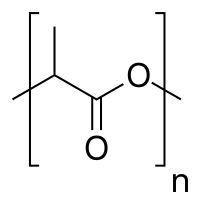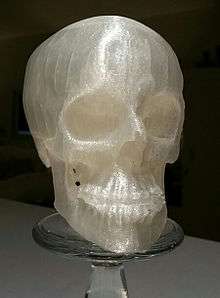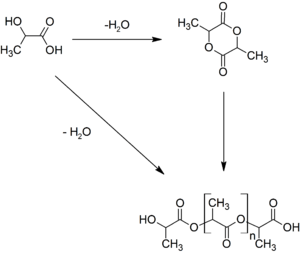Polylactic acid
Polylactic acid, or polylactide (PLA) is a thermoplastic polyester with backbone formula (C
3H
4O
2)
n or [–C(CH
3)HC(=O)O–]
n, formally obtained by condensation of lactic acid C(CH
3)(OH)HCOOH with loss of water (hence its name). It can also be prepared by ring-opening polymerization of lactide [–C(CH
3)HC(=O)O–]
2, the cyclic dimer of the basic repeating unit.
 | |
| Identifiers | |
|---|---|
| ChemSpider |
|
CompTox Dashboard (EPA) |
|
| Properties | |
| Density | 1.210–1.430 g·cm−3[1] |
| Melting point | 150 to 160 °C (302 to 320 °F; 423 to 433 K)[1] |
| 0 mg/ml [2] | |
| Hazards | |
| NFPA 704 (fire diamond) | |
Except where otherwise noted, data are given for materials in their standard state (at 25 °C [77 °F], 100 kPa). | |
| Infobox references | |
PLA has become a popular material due to it being economically produced from renewable resources. In 2010, PLA had the second highest consumption volume of any bioplastic of the world,[3] although it is still not a commodity polymer. Its widespread application has been hindered by numerous physical and processing shortcomings.[4] PLA is the most widely used plastic filament material in 3D printing.
The name "polylactic acid" does not comply with IUPAC standard nomenclature, and is potentially ambiguous or confusing, because PLA is not a polyacid (polyelectrolyte), but rather a polyester.[5]
Production
The monomer is typically made from fermented plant starch such as from corn, cassava, sugarcane or sugar beet pulp.
Several industrial routes afford usable (i.e. high molecular weight) PLA. Two main monomers are used: lactic acid, and the cyclic di-ester, lactide. The most common route to PLA is the ring-opening polymerization of lactide with various metal catalysts (typically tin octoate) in solution or as a suspension. The metal-catalyzed reaction tends to cause racemization of the PLA, reducing its stereoregularity compared to the starting material (usually corn starch).[6]
Another route to PLA is the direct condensation of lactic acid monomers. This process needs to be carried out at less than 200 °C; above that temperature, the entropically favored lactide monomer is generated. This reaction generates one equivalent of water for every condensation (esterification) step. The condensation reaction is reversible and subject to equilibrium, so removal of water is required to generate high molecular weight species. Water removal by application of a vacuum or by azeotropic distillation is required to drive the reaction toward polycondensation. Molecular weights of 130 kDa can be obtained this way. Even higher molecular weights can be attained by carefully crystallizing the crude polymer from the melt. Carboxylic acid and alcohol end groups are thus concentrated in the amorphous region of the solid polymer, and so they can react. Molecular weights of 128–152 kDa are obtainable thus.[6]
Polymerization of a racemic mixture of L- and D-lactides usually leads to the synthesis of poly-DL-lactide (PDLLA), which is amorphous. Use of stereospecific catalysts can lead to heterotactic PLA which has been found to show crystallinity. The degree of crystallinity, and hence many important properties, is largely controlled by the ratio of D to L enantiomers used, and to a lesser extent on the type of catalyst used. Apart from lactic acid and lactide, lactic acid O-carboxyanhydride ("lac-OCA"), a five-membered cyclic compound has been used academically as well. This compound is more reactive than lactide, because its polymerization is driven by the loss of one equivalent of carbon dioxide per equivalent of lactic acid. Water is not a co-product.[7]
The direct biosynthesis of PLA similar to the poly(hydroxyalkanoate)s has been reported as well.[8]
Another method devised is by contacting lactic acid with a zeolite. This condensation reaction is a one-step process, and runs about 100 °C lower in temperature.[9][10]
Properties
Chemical properties
Due to the chiral nature of lactic acid, several distinct forms of polylactide exist: poly-L-lactide (PLLA) is the product resulting from polymerization of L,L-lactide (also known as L-lactide). PLA is soluble in solvents, hot benzene, tetrahydrofuran, and dioxane.[11]
Physical and mechanical properties
PLA polymers range from amorphous glassy polymer to semi-crystalline and highly crystalline polymer with a glass transition 60–65 °C, a melting temperature 130-180 °C, and a tensile modulus 2.7–16 GPa.[12][13][14] Heat-resistant PLA can withstand temperatures of 110 °C.[15] The basic mechanical properties of PLA are between those of polystyrene and PET.[12] The melting temperature of PLLA can be increased by 40–50 °C and its heat deflection temperature can be increased from approximately 60 °C to up to 190 °C by physically blending the polymer with PDLA (poly-D-lactide). PDLA and PLLA form a highly regular stereocomplex with increased crystallinity. The temperature stability is maximised when a 1:1 blend is used, but even at lower concentrations of 3–10% of PDLA, there is still a substantial improvement. In the latter case, PDLA acts as a nucleating agent, thereby increasing the crystallization rate. Biodegradation of PDLA is slower than for PLA due to the higher crystallinity of PDLA. The flexural modulus of PLA is higher than polystyrene and PLA has good heat sealability.
Several technologies such as annealing,[16][17][18] adding nucleating agents, forming composites with fibers or nano-particles,[19][20][21] chain extending[22][23] and introducing crosslink structures have been used to enhance the mechanical properties of PLA polymers. Polylactic acid can be processed like most thermoplastics into fiber (for example, using conventional melt spinning processes) and film. PLA has similar mechanical properties to PETE polymer, but has a significantly lower maximum continuous use temperature.[24] With high surface energy, PLA has easy printability which makes it widely used in 3-D printing. The tensile strength for 3-D printed PLA was previously determined.[25]
There is also poly(L-lactide-co-D,L-lactide) (PLDLLA) – used as PLDLLA/TCP scaffolds for bone engineering.[26][27]
Solvent welding
PLA can be solvent welded using dichloromethane.[28] Acetone also softens the surface of PLA, making it sticky without dissolving it, for welding to another PLA surface.
Organic solvents for PLA
PLA is soluble in a range of organic solvents.[29] Ethylacetate, due to its ease of access and low risk of use, is of most interest. PLA 3D printer filament dissolves when soaked in ethylacetate, making it a useful solvent for cleaning 3D printing extruder heads or removing PLA supports. The boiling point of ethylacetate is low enough to also smooth PLA in a vapor chamber, similar to using acetone vapor to smooth ABS. Other safe solvents to use include propylene carbonate, which is safer than ethylacetate but is difficult to purchase commercially. Pyridine can also be used however this is less safe than ethylacetate and propylene carbonate. It also has a distinct bad fish odor.
Applications
PLA is used as a feedstock material in desktop fused filament fabrication 3D printers (e.g. RepRap).[30][31] PLA-printed solids can be encased in plaster-like moulding materials, then burned out in a furnace, so that the resulting void can be filled with molten metal. This is known as "lost PLA casting", a type of investment casting.[32]
PLA can degrade into innocuous lactic acid, so it is used as medical implants in the form of anchors, screws, plates, pins, rods, and as a mesh.[33] Depending on the exact type used, it breaks down inside the body within 6 months to 2 years. This gradual degradation is desirable for a support structure, because it gradually transfers the load to the body (e.g. the bone) as that area heals. The strength characteristics of PLA and PLLA implants are well documented.[34]
PLA can also be used as a decomposable packaging material, either cast, injection-molded, or spun.[33] Cups and bags have been made from this material. In the form of a film, it shrinks upon heating, allowing it to be used in shrink tunnels. It is useful for producing loose-fill packaging, compost bags, food packaging, and disposable tableware. In the form of fibers and nonwoven fabrics, PLA also has many potential uses, for example as upholstery, disposable garments, awnings, feminine hygiene products, and diapers. Thanks to its bio-compatibility and biodegradability, PLA has also found ample interest as a polymeric scaffold for drug delivery purposes.
Racemic and regular PLLA has a low glass transition temperature, which is undesirable. A stereocomplex of PDLA and PLLA has a higher glass transition temperatures, lending it more mechanical strength. It has a wide range of applications, such as woven shirts (ironability), microwavable trays, hot-fill applications and even engineering plastics (in this case, the stereocomplex is blended with a rubber-like polymer such as ABS). Such blends also have good form stability and visual transparency, making them useful for low-end packaging applications. Pure poly-L-lactic acid (PLLA), on the other hand, is the main ingredient in Sculptra, a long-lasting facial volume enhancer, primarily used for treating lipoatrophy of cheeks. Progress in biotechnology has resulted in the development of commercial production of the D enantiomer form, something that was not possible until recently.[35]
 Mulch film made of PLA-blend "bio-flex"
Mulch film made of PLA-blend "bio-flex" Biodegradable PLA cups
Biodegradable PLA cups Tea bags made of PLA. Peppermint tea is enclosed.
Tea bags made of PLA. Peppermint tea is enclosed. 3D printed human skull with data from computed tomography. Transparent PLA.
3D printed human skull with data from computed tomography. Transparent PLA.
Degradation
PLA is degraded abiotically by three mechanisms:[37]
- Hydrolysis: The ester groups of the main chain are cleaved, thus reducing molecular weight.
- Thermal degradation: A complex phenomenon leading to the appearance of different compounds such as lighter molecules and linear and cyclic oligomers with different Mw, and lactide.
- Photodegradation: UV radiation induces degradation. This is a factor mainly where PLA is exposed to sunlight in its applications in plasticulture, packaging containers and films.
The hydrolytic reaction is:
The degradation rate is very slow in ambient temperatures. A 2017 study found that at 25 °C in seawater, PLA showed no degradation over a year.[38]
Pure PLA foams are selectively hydrolysed in Dulbecco's modified Eagle's medium (DMEM) supplemented with fetal bovine serum (FBS) (a solution mimicking body fluid). After 30 days of submersion in DMEM+FBS, a PLLA scaffold lost about 20% of its weight.[39]
PLA samples of various molecular weights were degraded into methyl lactate (a green solvent) by using a metal complex catalyst.[40][41][42]
PLA also be degraded by some bacteria, such as Amycolatopsis and Saccharothrix. A purified protease from Amycolatopsis sp., PLA depolymerase, can also degrade PLA. Enzymes such as pronase and most effectively proteinase K from Tritirachium album degrade PLA.[43]
End of life

Four possible end of life scenarios are the most common:
- Recycling: which can be either chemical or mechanical. Currently, the SPI resin identification code 7 ("others") is applicable for PLA. In Belgium, Galactic started the first pilot unit to chemically recycle PLA (Loopla) . Unlike mechanical recycling, waste material can hold various contaminants. Polylactic acid can be chemically recycled to monomer by thermal depolymerization or hydrolysis. When purified, the monomer can be used for the manufacturing of virgin PLA with no loss of original properties (cradle-to-cradle recycling). End-of-life PLA can be chemically recycled to methyl lactate by transesterification.[42]
- Composting: PLA is biodegradable under industrial composting conditions, starting with chemical hydrolysis process, followed by the microbial digestion, to ultimately degrade the PLA.
- Incineration: PLA can be incinerated, leaving no residue and producing 19.5 MJ/kg (8,368 btu/lb) of energy.
- Landfill: the least preferable option is landfilling because PLA degrades very slowly in ambient temperatures.
See also
- Acrylonitrile butadiene styrene (ABS) - also used for 3D printing
- Cellophane, polyglycolide, plastarch material, poly-3-hydroxybutyrate – biologically derived polymers
- Polilactofate
- Polycaprolactone
- Zein, shellac – biologically derived coating materials
References
- "Material Properties of Polylactic Acid (PLA), Agro Based Polymers". Matbase - Material Properties Database. Archived from the original on 10 February 2012. Retrieved 6 February 2012.
- "Polylactic Acid. Material Safety Data Sheet" (PDF). ampolymer.com. Archived from the original (PDF) on 6 January 2009.
- Ceresana. "Bioplastics - Study: Market, Analysis, Trends - Ceresana". www.ceresana.com. Archived from the original on 4 November 2017. Retrieved 9 May 2018.
- Nagarajan, Vidhya; Mohanty, Amar K.; Misra, Manjusri (2016). "Perspective on Polylactic Acid (PLA) based Sustainable Materials for Durable Applications: Focus on Toughness and Heat Resistance". ACS Sustainable Chemistry & Engineering. 4 (6): 2899–2916. doi:10.1021/acssuschemeng.6b00321.
- Martin, O; Avérous, L (2001). "Poly(lactic acid): plasticization and properties of biodegradable multiphase systems". Polymer. 42 (14): 6209–6219. doi:10.1016/S0032-3861(01)00086-6.
- Södergård, Anders; Mikael Stolt (2010). "3. Industrial Production of High Molecular Weight Poly(Lactic Acid)". In Rafael Auras; Loong-Tak Lim; Susan E. M. Selke; Hideto Tsuji (eds.). Poly(Lactic Acid): Synthesis, Structures, Properties, Processing, and Applications. pp. 27–41. doi:10.1002/9780470649848.ch3. ISBN 9780470649848.
- Kricheldorf, Hans R.; Jonté, J. Michael (1983). "New polymer syntheses". Polymer Bulletin. 9 (6–7). doi:10.1007/BF00262719.
- Jung, Yu Kyung; Kim, Tae Yong (2009). "Metabolic Engineering of Escherichia coli for the production of Polylactic Acid and Its Copolymers". Biotechnology and Bioengineering. 105 (1): 161–71. doi:10.1002/bit.22548. PMID 19937727.
- Drury, Jim. "Cheaper, greener, route to bioplastic". reuters.com. Archived from the original on 1 December 2017. Retrieved 9 May 2018.
- Dusselier, Michiel; Wouwe, Pieter Van; Dewaele, Annelies; Jacobs, Pierre A.; Sels, Bert F. (3 July 2015). "Shape-selective zeolite catalysis for bioplastics production" (PDF). Science. 349 (6243): 78–80. Bibcode:2015Sci...349...78D. doi:10.1126/science.aaa7169. PMID 26138977.
- Garlotta, Donald (2001). "A Literature Review of Poly(Lactic Acid)". Journal of Polymers and the Environment. 9 (2): 63–84. doi:10.1023/A:1020200822435. Archived from the original on 26 May 2013.
- Lunt, James (3 January 1998). "Large-scale production, properties and commercial applications of polylactic acid polymers". Polymer Degradation and Stability. 59 (1–3): 145–152. doi:10.1016/S0141-3910(97)00148-1. ISSN 0141-3910.
- Södergård, Anders; Mikael Stolt (February 2002). "Properties of lactic acid based polymers and their correlation with composition". Progress in Polymer Science. 27 (6): 1123–1163. doi:10.1016/S0079-6700(02)00012-6.
- Middelton, John C.; Arthur J. Tipton (2000). "Synthetic biodegradable polymers as orthopedic devices". Biomaterial. 21 (23): 2335–2346. doi:10.1016/S0142-9612(00)00101-0. PMID 11055281.
- Gina L. Fiore; Feng Jing; Victor G. Young Jr.; Christopher J. Cramer; Marc A. Hillmyer (2010). "High Tg Aliphatic Polyesters by the Polymerization of Spirolactide Derivatives". Polymer Chemistry. 1 (6): 870–877. doi:10.1039/C0PY00029A.
- Nugroho, Pramono; Mitomo, Hiroshi; Yoshii, Fumio; Kume, Tamikazu (1 May 2001). "Degradation of poly(l-lactic acid) by γ-irradiation". Polymer Degradation and Stability. 72 (2): 337–343. doi:10.1016/S0141-3910(01)00030-1. ISSN 0141-3910.
- Urayama, Hiroshi; Kanamori, Takeshi; Fukushima, Kazuki; Kimura, Yoshiharu (1 September 2003). "Controlled crystal nucleation in the melt-crystallization of poly(l-lactide) and poly(l-lactide)/poly(d-lactide) stereocomplex". Polymer. 44 (19): 5635–5641. doi:10.1016/S0032-3861(03)00583-4. ISSN 0032-3861.
- Tsuji, H. (1 January 1995). "Properties and morphologies of poly(l-lactide): 1. Annealing condition effects on properties and morphologies of poly(l-lactide)". Polymer. 36 (14): 2709–2716. doi:10.1016/0032-3861(95)93647-5. ISSN 0032-3861.
- Urayama, Hiroshi; Ma, Chenghuan; Kimura, Yoshiharu (July 2003). "Mechanical and Thermal Properties of Poly(L-lactide) Incorporating Various Inorganic Fillers with Particle and Whisker Shapes". Macromolecular Materials and Engineering. 288 (7): 562–568. doi:10.1002/mame.200350004. ISSN 1438-7492.
- Trimaille, T.; Pichot, C.; Elaïssari, A.; Fessi, H.; Briançon, S.; Delair, T. (1 November 2003). "Poly(d,l-lactic acid) nanoparticle preparation and colloidal characterization". Colloid and Polymer Science. 281 (12): 1184–1190. doi:10.1007/s00396-003-0894-1. ISSN 0303-402X.
- Hu, Xiao; Xu, Hong-Sheng; Li, Zhong-Ming (4 May 2007). "Morphology and Properties of Poly(L-Lactide) (PLLA) Filled with Hollow Glass Beads". Macromolecular Materials and Engineering. 292 (5): 646–654. doi:10.1002/mame.200600504. ISSN 1438-7492.
- Li, Bo-Hsin; Yang, Ming-Chien (2006). "Improvement of thermal and mechanical properties of poly(L-lactic acid) with 4,4-methylene diphenyl diisocyanate". Polymers for Advanced Technologies. 17 (6): 439–443. doi:10.1002/pat.731. ISSN 1042-7147.
- Di, Yingwei; Iannace, Salvatore; Di Maio, Ernesto; Nicolais, Luigi (4 November 2005). "Reactively Modified Poly(lactic acid): Properties and Foam Processing". Macromolecular Materials and Engineering. 290 (11): 1083–1090. doi:10.1002/mame.200500115. ISSN 1438-7492.
- "Compare Materials: PLA and PETE". Makeitfrom.com. Archived from the original on 1 May 2011. Retrieved 11 April 2011.
- Giordano, R.A.; Wu, B.M.; Borland, S.W.; Cima, L.G.; Sachs, E.M.; Cima, M.J. (1997). "Mechanical properties of dense polylactic acid structures fabricated by three dimensional printing". Journal of Biomaterials Science, Polymer Edition. 8 (1): 63–75. doi:10.1163/156856297x00588. PMID 8933291.
- Lam, C. X. F.; Olkowski, R.; Swieszkowski, W.; Tan, K. C.; Gibson, I.; Hutmacher, D. W. (2008). "Mechanical and in vitro evaluations of composite PLDLLA/TCP scaffolds for bone engineering". Virtual and Physical Prototyping. 3 (4): 193–197. doi:10.1080/17452750802551298.
- Bose, S.; Vahabzadeh, S.; Bandyopadhyay, A. (2013). "Bone tissue engineering using 3D printing". Materials Today. 16 (12): 496–504. doi:10.1016/j.mattod.2013.11.017.
- Coysh, Adrian (12 April 2013). "Dichloromethane Vapor Treating PLA parts". Thingiverse.com. Archived from the original on 1 December 2017. Retrieved 9 May 2018.
- Sato, Shuichi; Gondo, Daiki; Wada, Takayuki; Nagai, Kazukiy (2013). "Effects of Various Liquid Organic Solvents on Solvent-Induced Crystallization of AMorphous Poly(lactic acid) Film". Journal of Applied Polymer Science. 129 (3): 1607–1617. doi:10.1002/app.38833.
- "PLA". Reprap Wiki. 4 April 2011. Archived from the original on 16 July 2011. Retrieved 11 April 2011.
- "PLA". MakerBot Industries. Archived from the original on 23 April 2011. Retrieved 11 April 2011.
- "Metal Casting with Your 3D Printer | Make". Make: DIY Projects and Ideas for Makers. Retrieved 30 November 2018.
- Rafael Auras; Loong-Tak Lim; Susan E. M. Selke; Hideto Tsuji, eds. (2010). Poly(Lactic Acid): Synthesis, Structures, Properties, Processing, and Applications. doi:10.1002/9780470649848. ISBN 9780470293669.
- Nazre, A.; Lin, S. (1994). Harvey, J. Paul; Games, Robert F. (eds.). Theoretical Strength Comparison of Bioabsorbable (PLLA) Plates and Conventional Stainless Steel and Titanium Plates Used in Internal Fracture Fixation. p. 53. ISBN 978-0-8031-1897-3.
- "Bioengineers succeed in producing plastic without the use of fossil fuels". Physorg.com. Archived from the original on 6 June 2011. Retrieved 11 April 2011.
- Guo, Shuang-Zhuang; Yang, Xuelu; Heuzey, Marie-Claude; Therriault, Daniel (2015). "3D printing of a multifunctional nanocomposite helical liquid sensor". Nanoscale. 7 (15): 6451–6. Bibcode:2015Nanos...7.6451G. doi:10.1039/C5NR00278H. PMID 25793923.
- Castro-Aguirre, E.; Iñiguez-Franco, F.; Samsudin, H.; Fang, X.; Auras, R. (December 2016). "Poly(lactic acid)—Mass production, processing, industrial applications, and end of life". Advanced Drug Delivery Reviews. 107: 333–366. doi:10.1016/j.addr.2016.03.010. PMID 27046295.
- Bagheri, Amir Reza; Laforsch, Christian; Greiner, Andreas; Agarwal, Seema (July 2017). "Fate of So-Called Biodegradable Polymers in Seawater and Freshwater". Global Challenges. 1 (4): 1700048. doi:10.1002/gch2.201700048. PMC 6607129. PMID 31565274.
- Pavia FC; La Carrubba V; Piccarolo S; Brucato V (August 2008). "Polymeric scaffolds prepared via thermally induced phase separation: tuning of structure and morphology". Journal of Biomedical Materials Research Part A. 86 (2): 459–466. doi:10.1002/jbm.a.31621. PMID 17975822.
- Román-Ramírez, Luis A.; Mckeown, Paul; Jones, Matthew D.; Wood, Joseph (4 January 2019). "Poly(lactic acid) Degradation into Methyl Lactate Catalyzed by a Well-Defined Zn(II) Complex". ACS Catalysis. 9 (1): 409–416. doi:10.1021/acscatal.8b04863.
- McKeown, Paul; Román‐Ramírez, Luis A.; Bates, Samuel; Wood, Joseph; Jones, Matthew D. (2019). "Zinc Complexes for PLA Formation and Chemical Recycling: Towards a Circular Economy". ChemSusChem. 12 (24): 5233–5238. doi:10.1002/cssc.201902755. ISSN 1864-564X. PMID 31714680.
- Román-Ramírez, Luis A.; McKeown, Paul; Shah, Chanak; Abraham, Joshua; Jones, Matthew D.; Wood, Joseph (20 May 2020). "Chemical Degradation of End-of-Life Poly(lactic acid) into Methyl Lactate by a Zn(II) Complex". Industrial & Engineering Chemistry Research: acs.iecr.0c01122. doi:10.1021/acs.iecr.0c01122. ISSN 0888-5885.
- Yutaka Tokiwa; Buenaventurada P. Calabia; Charles U. Ugwu; Seiichi Aiba (September 2009). "Biodegradability of Plastics". International Journal of Molecular Sciences. 10 (9): 3722–3742. doi:10.3390/ijms10093722. PMC 2769161. PMID 19865515.
External links
| Wikimedia Commons has media related to Polylactides. |

